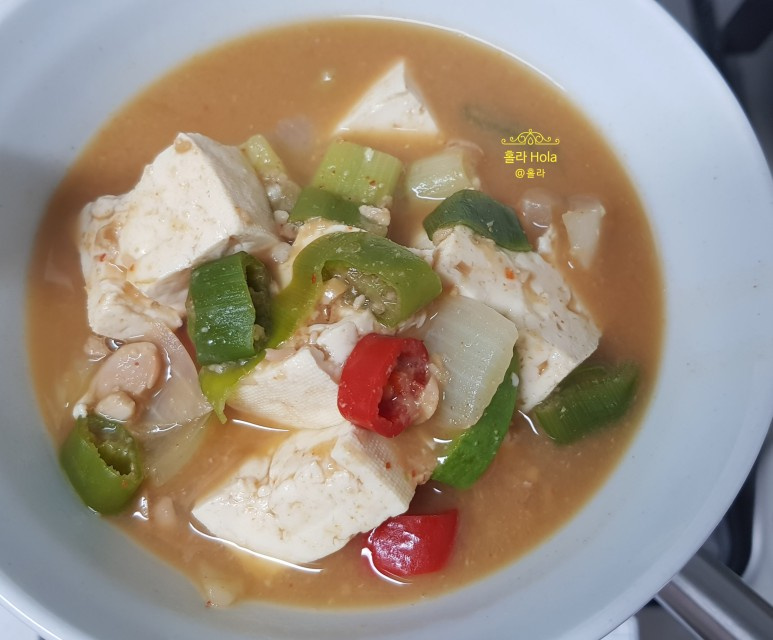Hearty Cheonggukjang and Doenjang Jjigae: A Tribute to Chef Lim Ji-ho
The Essence of Home Cooking! No More Stink! How to Make Delicious Cheonggukjang Doenjang Jjigae (feat. Late Chef Lim Ji-ho)

I’ve recreated the Cheonggukjang and Doenjang Jjigae recipe that the late Chef Lim Ji-ho showcased on MBN’s ‘The Makan Ha (家)’. Even without kimchi or pork, the combination of savory cheonggukjang and doenjang, abundant vegetables, and spicy Vietnamese chili peppers creates a deep and refreshing flavor. Nowadays, there are many low-odor cheonggukjang options, making it easy to enjoy at home. With just 1-2 hours of ventilation, you can eliminate any smell and savor a delicious bowl of cheonggukjang doenjang jjigae. This recipe uses rice water broth for an even richer and smoother taste.
Jjigae Ingredients- 4 Tbsp Cheonggukjang (fermented soybean paste)
- 2 Tbsp Doenjang (soybean paste)
- 550ml Rice Water (approx. 2.5 cups)
- 1/3 Zucchini (sliced into half-moons)
- 1/2 Onion (sliced)
- 3 Korean Green Chilies (finely chopped)
- 1.5 Red Chilies (finely chopped)
- 1/2 Scallion (finely chopped)
- 1 Tbsp Gochugaru (red pepper powder)
- 1 block Firm Tofu (cubed)
Broth Ingredients- 7 Dried Anchovies (with guts removed)
- 2 Dried Anchovy-like fish (Dippori/Bandeng-i)
- 1 Scallion Root
- 2 slices Ginger (thinly sliced)
- 1 piece Onion Skin
- 6 slices Radish (approx. 50g)
- 7 Dried Anchovies (with guts removed)
- 2 Dried Anchovy-like fish (Dippori/Bandeng-i)
- 1 Scallion Root
- 2 slices Ginger (thinly sliced)
- 1 piece Onion Skin
- 6 slices Radish (approx. 50g)
Cooking Instructions
Step 1
First, let’s make the basic broth for a rich jjigae. Place the 7 dried anchovies (with guts removed), a thoroughly washed scallion root, 6 slices of radish, 2 thin slices of ginger, clean onion skin, and 2 dippori (or bandeng-i) into a mesh broth bag. Using a bag makes it convenient to remove the ingredients later.

Step 2
Pour 550ml of rice water (the cloudy water left after rinsing rice) into a pot. Rice water is a secret ingredient that makes the jjigae extra smooth and savory.

Step 3
Add the prepared broth bag to the pot with the rice water and bring it to a boil over medium heat. Cover the pot and simmer for about 10 minutes to allow the flavors of the anchovies and dippori to fully infuse into the water.

Step 4
While the broth is simmering, prepare the vegetables for the jjigae. Slice the zucchini into half-moons and the onion into slices. Finely chop the Korean green chilies and red chilies for a spicy kick and vibrant color. Also, thinly slice the scallion diagonally. Prepping the vegetables like this ensures a smooth cooking process.

Step 5
Carefully remove and discard the broth bag. Dried ingredients like anchovies and kelp can make the soup cloudy, so remove them cleanly.

Step 6
Now, it’s time to develop the main flavor of the jjigae. Add 4 tablespoons of cheonggukjang directly into the boiling broth. Use a spoon to break apart the lumps and mix it in. You’ll start to smell the unique, savory aroma of cheonggukjang.

Step 7
After dissolving the cheonggukjang, place 2 tablespoons of doenjang into a fine-mesh sieve and dissolve it into the simmering broth. Sieving the doenjang ensures a smooth soup without any gritty texture. Using both cheonggukjang and doenjang complements each other, creating a deeper and richer flavor profile.

Step 8
Finally, add 1 block of cubed firm tofu and 1 tablespoon of gochugaru. Gently add the tofu so it doesn’t break apart while the jjigae is boiling. Now, simmer for a little longer until all the ingredients meld together, and your delicious cheonggukjang doenjang jjigae will be ready. You can also add a little minced garlic if you prefer.




